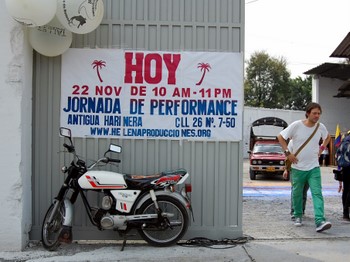Helena Productions,
Nov 18, 2008 - Nov 22, 2008
Cali, Colombia
7th Cali Performance Festival, Colombia
by Luisa Ungar
The state of liminality is characterized by its ambiguity, openness and indetermination. The sense of identity thus dissolves up to a point, creating a kind of disorientation. Liminality is a period of transition in which the normal limits of thought and behavior are relaxed. When people, places or things do not complete a transition they can become permanently liminal. Victor Turner, "Betwixt and Between:
The Liminal Period in Rites of Passage-, 1967. 1. The independent collective Helena Producciones(1) has been focusing on the creation of cultural devices that go beyond traditional management strategies for ten years. The Cali International Performance Festival, which Helena has been organizing since its second edition in 1998, reflects this approach and takes the shape of a significant national and international exhibition in which the organizers are not afraid to experiment and whose modus operandi constantly changes.(2) This management approach has made the Festival a gathering place for reassessing ideas about performance and for showcasing a variety of practices. At the same time, it has also managed to avoid reproducing traditional notions that are uncritically accepted, a condition often seen in events of this kind. The Festival has always been influenced by imaginaries that focus on its birthplace --the city of Cali-- while also showing a multitude of practices that have had a significant impact on the field of art in Colombia. The Festival changes and renews itself every year so there is a sort of consistency with the type of art practices it showcases, while maintaining the non-conformist rebelliousness that was behind the non-object-based art actions of the early 70s, which shunned traditional forms of representation. The Seventh Festival was not afraid to "go out on a limb", which according to Helena is what characterizes its productions, and we attended an event that turned out to be open, ambiguous and indeterminate. The invitation to participate centered on "the topic of borders!, although the invitation itself stated that "as is customary, the subject matter will be open". As in past festivals, the call was to "propose a project to be presented in Cali, in a public space, in an exhibition room, or to form part of performance activities." Participants included those who answered the invitation and were chosen by Helena, and other artists (both national and international) who were invited directly, as well as the speakers. As usual, curators and local and foreign promoters were also invited to bring participants thus highlighting the purpose of the festival, which is defined by the absence of a single curatorial approach. Unscheduled interventions also took place during the festival. Altogether, some seventy artists, ten speakers and a public consisting of locals and foreigners alike attended a festival that featured talks, concerts, videos, a party at the Hotel Aristi and workshops. The performances were held on the last day in abandoned warehouses formerly used to store flour. The wide variety of participants was evident; the talks featured artists, curators, promoters, and human-rights activists, whereas the activities covered a broad range of practices including performance, contemporary dance, concerts, and a variety of actions, along with the sale of medicinal plants, publications, food, etc. Several of the talks focused on the definitions of performance, on what is considered action art, the limits of "live" arts, and whether it was important to even address these issues. Participants evidenced the relationship between performance practices that address a socio-cultural context "outside the field of art" (such as marches and rituals), those that come under the heading of the fine arts (from the standpoint of performance), as well as the tensions artists face working at the point
|











